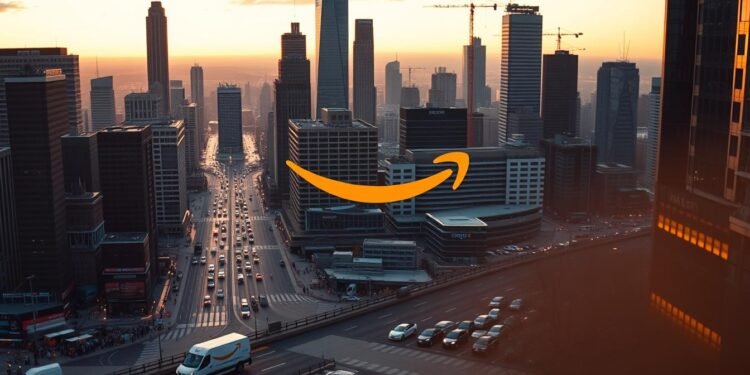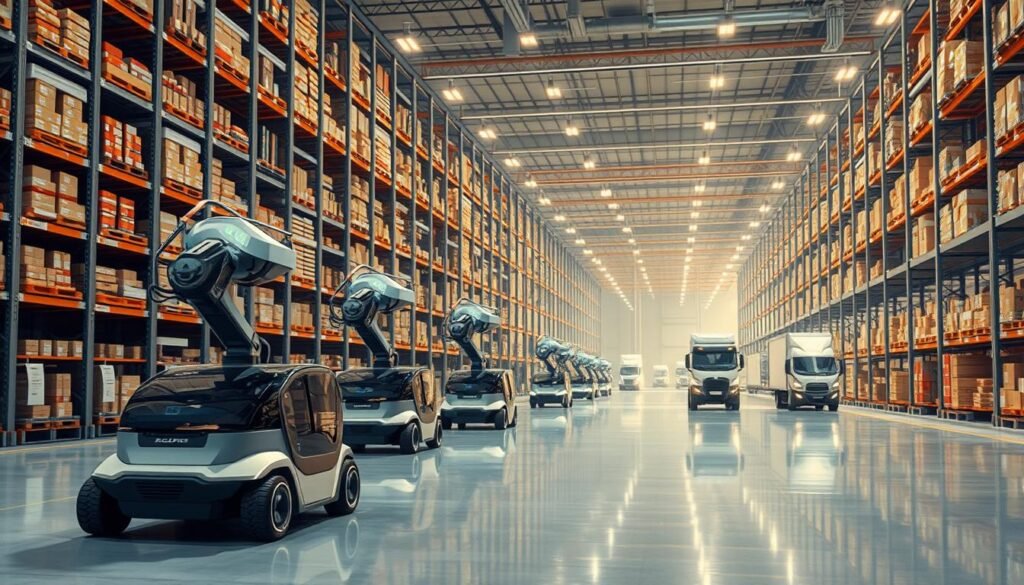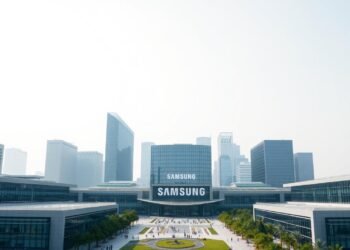What began as an online bookstore in 1994 has transformed into one of the most influential companies in the world. The journey from a modest garage operation to a trillion-dollar empire is nothing short of extraordinary.
This company redefined eCommerce, pioneered cloud computing, and shaped modern consumer expectations. Its relentless focus on innovation and customer satisfaction fueled rapid expansion. Key moments—like the 1997 IPO, AWS launch, and Prime membership—propelled its dominance.
But how did it maintain such explosive growth while facing fierce competition? The answer lies in a bold vision and execution. The founder’s “Get Big Fast” philosophy drove aggressive scaling, while a customer-first approach built lasting loyalty.
Key Takeaways
- Started as an online bookstore in 1994
- Went public in 1997, marking rapid expansion
- Revolutionized retail with Prime and AWS
- Prioritized customer experience for long-term success
- Faces challenges in maintaining market leadership
From Garage Startup to Global Giant: The Amazon Story Begins
In a small Bellevue garage, a revolution in retail was quietly taking shape in 1994. Jeff Bezos’ fledgling company, initially named Cadabra, would soon redefine how the world shopped. The pivot to “Amazon” reflected his ambition—a nod to Earth’s largest river, symbolizing scale.
The Humble Origins: Cadabra to Amazon
Books were the perfect launchpad. Bezos chose them for their uniform size, easy shipping, and universal appeal. The initial business model prioritized market share over profits, a gamble that fueled rapid growth.
Jeff Bezos’ Vision: Why Books Were Just the Start
From day one, Bezos’ three-pillar philosophy—customer focus, relentless invention, and long-term patience—guided decisions. His 1997 shareholder letter declared expansion into new categories, foreshadowing moves into music and electronics.
“Get Big Fast” wasn’t just a slogan. It was a blueprint to dominate the retail world, turning a garage project into a trillion-dollar empire.
1995-2000: Building the Foundation of an Online Empire
The late 1990s marked a turning point for the eCommerce pioneer as it transitioned from scrappy startup to Wall Street darling. Annual sales surged from $16 million in 1996 to $600 million by 1998, a staggering 3,650% growth in just two years. This explosive trajectory was fueled by a bold IPO and relentless reinvestment.
Going Live: The First Website Launch
In 1995, the company’s barebones website went live, offering a catalog of over one million books. Unlike other companies, it focused on user experience, with features like customer reviews and 1-Click ordering. These innovations set the stage for its dominance.
The IPO That Changed Everything
May 15, 1997, saw shares debut at $18, raising $54 million. Bezos famously warned investors to expect losses as capital was funneled into warehouses and tech infrastructure. By 1999, Time Magazine crowned him “Person of the Year,” validating the “Get Big Fast” ethos.
The strategy paid off. A modest $5 million profit in Q1 2001 proved scalability, while acquisitions like Junglee (1998) expanded its marketplace. Stock became currency for growth, funding the logistics network that later powered Prime.
Expanding Beyond Books: Amazon’s Strategic Pivot
By 1999, the company had outgrown its books-only roots, signaling a retail revolution. The next phase focused on diversification, transforming the platform into a one-stop store for everything from CDs to electronics. This shift wasn’t just about products—it redefined how businesses operated online.
Music, Movies, and More: Diversifying the Catalog
Adding music and DVDs in 1998 tested new verticals. By 2000, the Associates program had 350,000+ members promoting these items. The strategy worked—sales soared as customers embraced the convenience of a unified shopping experience.
Opening the Doors to Third-Party Sellers
The November 1999 Marketplace launch invited external vendors to compete alongside the company’s inventory. Sellers gained access to millions of shoppers, while the platform earned fees per transaction. eBay’s 1995 head start posed a challenge, but robust seller tools (like inventory APIs) leveled the field.
In 2006, the Fulfillment by Amazon (FBA) service revolutionized shipping logistics. Sellers could now leverage the company’s warehouses, ensuring faster deliveries. By 2009, the $1.2 billion Zappos acquisition further cemented dominance in third-party sales—now accounting for 60%+ of total revenue.
The Birth of Amazon Web Services (AWS)
In 2006, a quiet tech revolution began when an internal project went public. Originally built to streamline the company’s own infrastructure, AWS became a game-changer for businesses worldwide. It turned costly server rooms into scalable, pay-as-you-go solutions.
From Internal Tool to Profit Powerhouse
The internal team’s infrastructure fix quickly outpaced retail profits. By 2024, AWS offered 200+ services, from data storage to AI tools. Its global reach spans 32 regions and 102 zones, powering 40% of the public cloud market.
Startups flocked to AWS for its elasticity—scaling resources up or down in minutes. Traditional data centers couldn’t match its pricing or speed. Lambda’s 2014 serverless computing removed even more barriers, letting developers focus on code, not hardware.
How AWS Revolutionized Cloud Computing
Before AWS, companies wasted millions on unused server capacity. AWS’s pay-per-use model slashed costs and democratized access to high-end technology. SageMaker (2017) brought machine learning to mainstream developers, while sustainability pledges aimed for 100% renewable energy by 2025.
Today, AWS isn’t just a service—it’s the invisible backbone of apps like Netflix and Airbnb. Its innovations continue to shape how businesses leverage cloud technology, proving that the best solutions often start as internal fixes.
Amazon Prime: Redefining Customer Loyalty
In 2005, a loyalty program changed how people shop online forever. Prime’s two-day shipping promise wasn’t just convenient—it set a new standard for eCommerce. Over time, it grew into a powerhouse of perks, from streaming to exclusive deals.
The Launch and Evolution of Prime Benefits
Initially priced at $79/year, Prime’s free shipping model hooked millions. By 2011, it added Instant Video, a Netflix rival. Today, members get groceries, music, and even prescription discounts.
Prime Video and the Entertainment Play
The 2017 Oscar win for “The Salesman” proved its digital services could compete with Hollywood. A $16B content budget fuels originals like “The Boys” and NFL’s Thursday Night Football. The 2022 MGM acquisition ($8.5B) added 4,000+ films to its library.
Global hits like “Mirzapur” (India) and “LOL” (Japan) showcase localized storytelling. Cross-selling Fire TV devices further ties hardware to content, creating a seamless ecosystem for subscribers.
Kindle and the Digital Reading Revolution
The digital reading landscape changed forever in 2007 with the launch of a groundbreaking device. The Kindle’s paper-like display and portable design made ebooks appealing to mainstream audiences. Within years, it dominated the market, accounting for over 80% of ebook sales by 2010.
Disrupting Publishing with E-Readers
Electronic ink technology solved the eye strain issues of traditional screens. The original Kindle stored 200 books—a library in your pocket. Its instant download feature via Whispernet revolutionized book access.
Whispersync became a game-changer, letting readers switch between devices without losing their place. This seamless service extended to audiobooks after the 2008 Audible acquisition ($300M). Today, over 1 million audiobook titles are available.
Building a Content Empire
Amazon Publishing launched in 2011, giving writers direct access to readers. The ACX platform connected authors with narrators, creating professional audiobooks. Bestsellers like “The Martian” proved self-publishing could rival traditional houses.
The 2014 ComiXology purchase brought comics into the ecosystem. Alexa integration later enabled hands-free audiobook listening. From hardware to content, every innovation reinforced Kindle’s market dominance.
Acquisitions and Expansions: Amazon’s Growth Strategy
Strategic acquisitions have fueled expansion beyond eCommerce, reshaping industries from groceries to healthcare. The company’s playbook combines bold purchases with seamless integration into its ecosystem. Each deal targets specific market gaps while reinforcing long-term dominance.
Whole Foods and the Grocery Market Gamble
The $13.7 billion Whole Foods deal in 2017 marked a physical retail revolution. This move blended the company’s logistics with 500+ premium grocery locations. Shoppers gained two-hour delivery, while the business model expanded into perishables.
Prime members received exclusive discounts, driving membership growth. The acquisition also tested cashier-less Just Walk Out technology. Grocery sales tripled within three years, proving brick-and-mortar could complement digital platforms.
Key Acquisitions That Shaped Amazon’s Future
Kiva Systems’ robotics transformed warehouses in 2012. Automated shelves cut order processing from hours to minutes. Today, 750,000+ mobile robots handle inventory globally.
Twitch’s $970 million purchase leveraged AWS’ cloud computing power for live streaming. The gaming platform now hosts 30 million daily users. Meanwhile, Zoox’s autonomous vehicles aim to reinvent last-mile delivery.
Healthcare became a priority with PillPack’s pharmacy services and One Medical’s clinics. The $3.9 billion 2023 deal gives access to 815,000 patients. Smart home dominance grew through Ring’s security systems, integrated with Alexa.
Critics argue these deals invite antitrust scrutiny. Regulators now examine whether acquisitions stifle competition across multiple sectors. Despite challenges, the strategy continues driving innovation and market control.
Innovations in Logistics and Delivery
Robots and drones are rewriting the rules of last-mile delivery worldwide. The company’s logistics network combines massive fulfillment centers with experimental technology to meet rising consumer expectations. This dual approach keeps packages moving faster while testing tomorrow’s solutions today.
Fulfillment Centers and the Speed Promise
Over 175 fulfillment centers worldwide form the backbone of Prime’s two-day shipping. These warehouses use robotic drive units to move shelves, cutting processing time by 75%. Advanced algorithms predict demand, positioning products closer to likely buyers.
The $1B Industrial Innovation Fund accelerates automation breakthroughs. In 2022, new sorting arms could handle 1,500 items per hour. This service infrastructure now delivers 60% of orders within same-day or next-day windows in major cities.
Drone Delivery and Future Tech Experiments
Prime Air received FAA approval in 2020 after years of testing. The Lockeford, California hub became the first to offer 30-minute drone drops for small packages. Regulatory hurdles remain, including altitude limits and noise restrictions.
Autonomous solutions extend beyond drones. Scout sidewalk robots completed 100,000 test deliveries in 2019. Project Kuiper’s satellite constellation aims to enhance connectivity for rural deliveries, while AWS edge computing supports real-time routing.
These innovations share one goal: making the delivery process invisible. As automation spreads from warehouses to doorsteps, the definition of “fast shipping” continues to evolve.
Amazon’s Cultural Impact and Controversies
No company has reshaped modern commerce while sparking as much debate as this retail giant. Its innovations created unparalleled convenience but also triggered scrutiny across labor, privacy, and market competition. This duality defines its legacy.
Changing Retail Forever: The “Amazon Effect”
Small businesses faced existential threats as the company prioritized speed and low prices. Local bookstores, for example, saw sales drop 40% post-2010 as shoppers migrated online. The “everything store” model forced rivals to adopt similar logistics or perish.
Yet its marketplace also empowered entrepreneurs. Over 60% of sales now come from third-party sellers. This paradox—disrupting while enabling—shows its complex role in global retail.
Workplace Criticisms and Public Scrutiny
Warehouse conditions drew fire after 2021 unionization efforts in Alabama. Reports cited strict productivity quotas—some people processed 300+ items hourly. The $61M COVID safety fines highlighted risks during peak demand.
Tracking systems monitor breaks and pack times via wearable devices. Critics argue this creates undue stress, though the company claims it improves efficiency and safety.
Facial recognition tech sparked backlash over racial bias concerns. Lawmakers questioned Rekognition’s use by police, leading to a 2020 moratorium. The 2023 $30M Ring settlement resolved privacy lawsuits alleging unchecked employee data access.
Despite controversies, the company pledged carbon neutrality by 2040. Solar farms now power fulfillment centers, a fact often overshadowed by criticism. Its Leadership Principles—like “Customer Obsession”—sometimes clash with worker welfare claims, fueling ongoing debate.
Jeff Bezos’ Leadership and Legacy
Few leaders have reshaped industries as profoundly as Jeff Bezos. His 27-year tenure as CEO redefined retail, cloud computing, and space exploration. The core philosophy? “Customer First“—a mantra that prioritized long-term loyalty over short-term profits.
“Customer First”: The Philosophy Behind Success
Bezos famously left an empty chair in meetings to symbolize the customer’s presence. This mindset fueled innovations like Prime and AWS. Unlike traditional companies, he embraced failure as a stepping stone, calling experiments like the Fire Phone “expensive tuition.”
His 1997 shareholder letter outlined this vision: “It’s all about the long term.” Decades later, that patience paid off. The Earth Fund pledged $200M to combat climate change, reflecting his expanded focus beyond commerce.
Bezos’ Transition from CEO to Executive Chairman
In Q2 2021, Bezos handed the CEO role to Andy Jassy, architect of AWS. The move marked a strategic shift—focusing on ventures like Blue Origin and The Washington Post. Under his ownership, the Post reversed years of decline, tripling digital subscriptions.
He retains 10% ownership and influence, ensuring continuity. Meanwhile, Blue Origin aims to democratize space travel, proving his ambitions extend far beyond Earth.
Amazon Today: A Trillion-Dollar Behemoth
Standing at the forefront of global commerce, this tech giant now faces unprecedented challenges despite its dominance. Its reach spans cloud computing, retail, and entertainment, yet regulatory scrutiny and fierce competition test its resilience.
Market Dominance Across Industries
The company’s services power 40% of the global cloud market through AWS. Retail sales topped $500 billion in 2023, with Prime memberships driving loyalty. Meanwhile, its logistics network delivers 60% of orders within a day.
Third-party sellers account for over half its revenue, showcasing marketplace strength. Innovations like cashier-less stores and drone deliveries keep it ahead. Yet, this expansion invites scrutiny.
Current Challenges and Competitors
The 2023 FTC lawsuit alleges antitrust violations, targeting Prime’s bundling tactics. Microsoft and Google now challenge AWS’s lead in AI-driven cloud services.
New rivals like TikTok Shop and SHEIN threaten its eCommerce stronghold with viral social commerce models. Counterfeit products also plague its marketplace, despite AI detection tools.
Workforce tensions persist, with unionization efforts gaining people’s support. Sustainability pledges face skepticism, as emissions rose 18% in 2022 despite renewable energy investments.
Over time, balancing growth with ethics will define its legacy. Can it adapt while maintaining innovation? The next decade holds the answer.
Conclusion: The Enduring Legacy of Amazon
Three decades of innovation have cemented this company’s place in history. From books to cloud computing, its journey redefined entire industries. The blend of retail dominance and tech prowess created a unique dual identity.
Jeff Bezos’ three-pillar philosophy—customer obsession, long-term thinking, and bold experimentation—remains its foundation. Yet challenges loom in the AI era, with rivals closing the gap in cloud services and eCommerce.
The “Day 1” mindset keeps it agile despite its scale. As it navigates regulatory scrutiny and evolving markets, one truth endures: its impact on how we shop, work, and connect is undeniable.
Few ventures achieve such lasting success while sparking global change. The next chapter will test whether it can uphold its legacy while adapting to tomorrow’s demands.
FAQ
What was the original name of Amazon before it changed?
The company was initially named Cadabra, but Jeff Bezos quickly changed it to avoid confusion with “cadaver.” The name Amazon was chosen to reflect vast scale, like the river.
Why did Amazon start by selling books online?
Books were an ideal first product—easy to ship, widely available, and with a massive global demand. This low-risk approach allowed the company to refine its business model before expanding.
When did Amazon go public, and how did it impact growth?
The IPO launched in 1997 at per share, raising critical capital. This fueled rapid expansion into new markets and laid the groundwork for future innovations like AWS and Prime.
How did Amazon Web Services (AWS) begin?
AWS started as an internal tool to manage the company’s own infrastructure. Recognizing its potential, Amazon opened it to other businesses in 2006, revolutionizing cloud computing.
What makes Amazon Prime so successful?
Prime’s fast shipping, bundled perks like streaming, and exclusive deals created unmatched loyalty. Its subscription model ensures steady revenue while keeping customers engaged.
How did the Kindle change the publishing industry?
The Kindle popularized e-readers, making digital books mainstream. Amazon then leveraged this success to launch its own publishing division, disrupting traditional models.
What role do acquisitions play in Amazon’s strategy?
Key purchases like Whole Foods and Zappos helped Amazon dominate new sectors. These moves expand its one-stop shop appeal while eliminating competitors.
What controversies has Amazon faced?
Criticisms include workplace conditions, antitrust concerns, and its impact on small businesses. Despite this, its customer-first approach keeps demand high.
How did Jeff Bezos shape Amazon’s culture?
Bezos prioritized long-term innovation over short-term profits. His leadership fostered risk-taking, from drone delivery experiments to space ventures via Blue Origin.
What are Amazon’s biggest challenges today?
Rising competition (like Walmart and Shopify), regulatory scrutiny, and sustaining growth in digital services are key hurdles as it evolves beyond retail.










